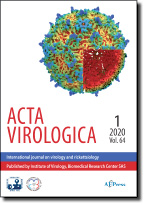Journal info
|
||
Select Journal
Journals
Bratislava Medical Journal Endocrine Regulations General Physiology and Biophysics Neoplasma Acta Virologica Current articles 2023 2022 2021 2020 2019 2018 2017 2016 2015 2014 2013 2012 2011 2010 2009 2008 2007 2006 2005 2004 2003 Studia Psychologica Cardiology Letters Psychológia a patopsych. dieťaťa Kovove Materialy-Metallic Materials Slovenská hudbaWebshop Cart
Your Cart is currently empty.
Info: Your browser does not accept cookies. To put products into your cart and purchase them you need to enable cookies.
Acta Virologica Vol.59, No.2, p.125-139, 2015 |
||
| Title: Association of tomato leaf curl New Delhi virus DNA-B with bhendi yellow vein mosaic virus in okra showing yellow vein mosaic disease symptoms | ||
| Author: V. VENKATARAVANAPPA, C. N. LAKSHMINARAYANA REDDY, S. JALALI, M. KRISHNA REDDY | ||
| Abstract: Okra samples showing yellow vein mosaic, vein twisting and bushy appearance were collected from different locations of India during the surveys conducted between years 2005–2009. The dot blot and PCR detection revealed that 75.14% of the samples were associated with monopartite begomovirus and remaining samples with bipartite virus. Whitefly transmission was established for three samples representing widely separated geographical locations which are negative to betasatellites and associated with DNA-B. Genome components of these three representative isolates were cloned and sequenced. The analysis of DNA-A-like sequence revealed that three begomovirus isolates shared more than 93% nucleotide sequence identity with bhendi yellow vein mosaic virus from India (BYVMV), a monopartite begomovirus species that was reported previously as causative agent of bhendi yellow mosaic disease in association of bhendi yellow vein mosaic betasatellite. Further, the DNA-B-like sequences associated with the three virus isolates shared no more than 90% sequence identity with tomato leaf curl New Delhi virus (ToLCNDV). Analyses of putative iteron-binding sequence required for trans-replication suggests that begomovirus sequences shared compatible rep-binding iterons with DNA-B of ToLCNDV. Our data suggest that the monopartite begomovirus associated with okra yellow vein disease has captured DNA-B of ToLCNDV to infect okra. Widespread distribution of the complex shows the increasing trend of the capturing of DNA-B of ToLCNDV by monopartite begomoviruses in the Indian subcontinent. The recombination analysis showed that the DNA-A might have been derived from the inter-specific recombination of begomoviruses, while DNA-B was derived from the ToLCNDV infecting different hosts. |
||
| Keywords: PCR; begomovirus; yellow vein mosaic; recombination; whitefly; phylogeny | ||
| Published online: 22-Jun-2015 | ||
| Year: 2015, Volume: 59, Issue: 2 | Page From: 125, Page To: 139 | |
| doi:10.4149/av_2015_02_125 |
||
|
|
 download file download file |
|

